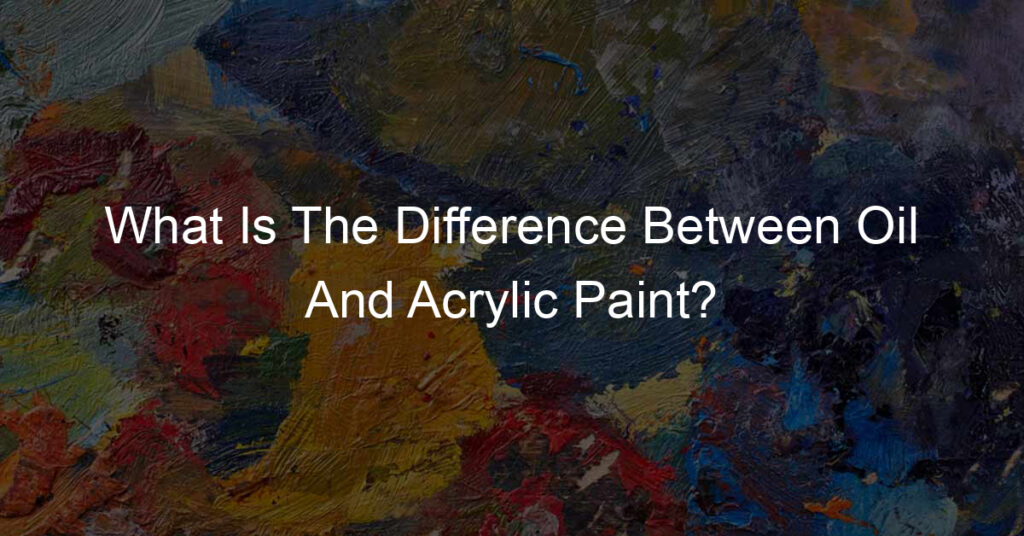Oil painting and acrylic painting are two very popular types of painting. They both have their own unique benefits, as well as drawbacks. In order to decide which type of painting is right for you, it’s important to understand the differences between the two.
Oil paints are made from pigments that are mixed with a drying oil, such as linseed oil. This mixture forms a slow-drying paint that allows for great flexibility and subtlety of color. However, because oil paints take so long to dry, they can be difficult to work with, especially in warm weather conditions.
Acrylic paints, on the other hand, are water-based and much faster drying than oil paints. This makes them more convenient for quick sketches or paintings. Acrylics can also be diluted with water to create various effects and textures. However, they can sometimes be brittle and lack the subtlety of oil paints.
Oil paint and acrylic paint are both popular choices for artists, but there are some key differences between the two. Oil paint is made from pigments that are suspended in a drying oil, such as linseed oil. Acrylic paint is made from pigments that are suspended in acrylic resin.
One of the biggest differences between oil and acrylic paint is the drying time. Oil paint can take days or even weeks to fully dry, while acrylic paint dries much more quickly. This means that you have to be more careful when working with oil paint, as it can smudge easily before it dries completely. Acrylic paint is also less likely to yellow over time than oil paint.
Another difference between these two types of paint is the way they interact with the surface you are painting on. Oil paint can be applied very thickly, and it will not crack as it dries. Acrylic paint dries quickly, so it is not ideal for painting thick layers. However, it can be thinned out with water to create a wash of color.
Finally, oil paint and acrylic paint have different effects when mixed with other mediums. Oil paint remains flexible when mixed with other materials, while acrylic paint becomes hard and brittle. This means that you can create interesting textures by mixing oil paint with other substances, but this is not possible with acrylic paint.
In what way is oil paint better than acrylic?
Oil paints have a number of advantages over acrylics. They are more flexible, allowing you to create subtle gradations of color. They also take longer to dry, giving you more time to work with the paint and make changes. Oil paints are also less likely to yellow over time than acrylics.
In what way is acrylic paint better than oil?
Acrylic paints have some advantages over oil paints as well. They dry much faster, so you can work more quickly with them. They are also less likely to crack as they dry. Acrylics can be thinned out with water to create interesting effects.
Can you use oil or acrylic paints for outdoor murals?
When it comes to painting an outdoor mural, there are a few different options you have in terms of material. Two of the most popular materials used for these types of projects are oil and acrylic paints. Both of these paints have their advantages and disadvantages, so it’s important to understand the best option for your artwork.
Oil paint is known for its high quality, superior covering power, and rich color saturation. It is also more expensive than acrylic paint, making it a good choice for those looking for a more permanent piece of art. However, when painted outdoors, oil paint does need to be protected from moisture and other external elements with a sealant or other preservative, otherwise the colors can fade quickly over time.
Acrylic paint is often preferred by artists due to its affordability, easy application, and quick drying process. It is also less likely to fade or discolor over time when exposed to the elements compared to oil paints. In addition, acrylic paints are available in a variety of hues which makes it easier to create dynamic murals fit with vibrant coloring that will stay true to your original vision even after a longer period of time outdoors. On the downside however, acrylics don’t typically offer as much coverage as oils do – meaning that if you want your mural design to look more refined and detailed then it may require multiple coats with acrylics before reaching your desired outcome when compared with oil paints.

What is the drying time for oil painting compared to acrylic paint?
Oil paint and acrylic paint are two of the most common types of art supplies used for creating artwork. Both painting mediums have distinct characteristics and techniques that require unique approaches to application and finishing.
One of the biggest differences between oil paint and acrylic paint is the drying time, which can affect how quickly a work of art can be completed. Oil paints are thicker than acrylic paints, as they contain natural oils such as linseed or safflower oil, which take longer to dry.
Depending on factors like the thickness of the application and the temperature surrounding it, it may take hours or days for oil paintings to completely dry before they can be varnished or hung up. Conversely, acrylic paints contain an emulsion resin that makes them dry much faster – often within hours – enabling artists to apply multiple layers quickly and finish work within a shorter amount of time.
How do you mix the two types of paints together to create a different effect?
Mixing oil and acrylic paints together can be a great way to create unique effects in your artwork. Blending the two different types of paint can result in interesting textures, colors, and hues that you wouldn’t get with either type of paint alone.
There are several techniques for mixing oil and acrylic paints, from simple color blending to more complex techniques such as layering or marbling. No matter what technique you use, it is important to understand how the properties of each medium affect the results when they are combined.
One popular method for combining oil and acrylic paint is called ‘dry brushing’. This technique involves lightly dragging a dry brush loaded with one type of paint across an area painted with the other type.
The resulting effect depends on which kind of paint was used first; if you start with oil-based paints then adding dry brushed layers of acrylic will create a textured look similar to glazing, while starting with acrylics will give a slightly softer feel due to its sheerer nature.
| Aspect | Oil Paint | Acrylic Paint |
|---|---|---|
| Drying Time | Slower drying time can take days or even weeks to dry | Faster drying time can dry within minutes to hours depending on thickness and humidity |
| Thinners | Thinned with solvents such as turpentine or mineral spirits | Thinned with water or acrylic mediums |
| Surface | Can be used on a wider range of surfaces including canvas, wood, and metal | Best used on absorbent surfaces such as canvas or paper |
| Appearance | Rich and lustrous with a longer drying time, can be blended and layered easily | Quick-drying with a flatter and more uniform appearance can be mixed with a variety of mediums for texture and gloss |
| Cleaning | Clean brushes and tools with solvents such as turpentine or mineral spirits | Clean brushes and tools with water or soap |
| Price | More expensive due to the cost of materials and production | Less expensive due to the ease of production and affordability of materials |
| Usage | Commonly used by professional artists for traditional painting techniques and longer projects | Commonly used by beginners and hobbyists for fast-drying projects and mixed media applications |
What are the tips on how to best use oil and acrylic paint?

The first tip for using oil and acrylic paints is to understand the properties of each medium. The viscosity, drying time, and opacity of the paints will all affect how they blend together and the final appearance of your artwork.
Before you start painting, make sure to get familiar with the properties of both oils and acrylics so that you can anticipate how they will interact with one another when combined. Another key tip for using oil and acrylic paints is to plan ahead and think about which colors you are going to use in advance.
Acrylics can be mixed together directly on a palette or canvas while oil paints need to be pre-mixed in order for optimal results; this means that if you want to combine several different colors, it’s best to have them ready before you begin painting.
What are some common uses for oil paint?
Oil paints have been a popular choice among artists for centuries, due to their versatility and ability to create rich and vibrant colors. Oil paints are commonly used for painting portraits, still life scenes, or other realistic images that require fine details or subtle shading.
They are also often used in landscape paintings because of the luxurious feel they impart to the work. In addition, oil paints can be mixed with other mediums such as waxes, pastels, and varnishes to add further depth and texture to a piece.
More recently, oil paint is also being used in abstract works thanks to its capability to produce textures that acrylics cannot achieve. Artists can manipulate the thickness of their brushstrokes or use a palette knife to create unique effects on canvas.
Oil paint is also ideal for glazing – a technique where translucent layers of different colors are applied one after another in order to build up luminous hues and richer tones. Due to its slow drying time, artists can easily go back over their work if they need to adjust something without having to start all over again.
What are some common uses for acrylic paint?
Acrylic paint is a versatile medium that has become increasingly popular in recent years due to its quick drying time and ease of use. It is most commonly used for painting on canvas and other surfaces such as wood, glass, metal, and even fabric.
Acrylics are great for creating both abstract and realistic artworks, as they can be layered to create unique textures or blended together to achieve subtle color gradations. They are also perfect for murals and street art since they can be applied quickly and dry almost instantly so that multiple layers can be added rapidly.
Another advantage of using acrylic paints is their affordability; they are relatively inexpensive compared to oil paints which makes them an ideal choice for those who have a limited budget but still want to create beautiful pieces of artwork.

Summary
Oil paint and acrylic paint are two of the most common types of art supplies used for creating artwork. Both painting mediums have distinct characteristics and techniques that require unique approaches to application and finishing.
One of the biggest differences between oil paint and acrylic paint is the drying time, which can affect how quickly a work of art can be completed. Oil paints are thicker than acrylic paints, as they contain natural oils such as linseed or safflower oil, which take longer to dry whereas acrylic paints contain an emulsion resin that makes them dry much faster – often within hours.
Other key differences between oil and acrylic include their opacity – oil paints tend to provide a more opaque finish while also allowing light to pass through in layers; this gives paintings created with oils a luminous quality that’s difficult to achieve with other mediums.
Acrylics on the other hand offer greater flexibility due to their water-resistant nature which means they can also be used outdoors without fear of fading or deterioration over time.


















